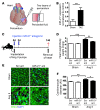Cardiac fibroblast-derived microRNA passenger strand-enriched exosomes mediate cardiomyocyte hypertrophy
- PMID: 24743145
- PMCID: PMC4001534
- DOI: 10.1172/JCI70577
Cardiac fibroblast-derived microRNA passenger strand-enriched exosomes mediate cardiomyocyte hypertrophy
Abstract
In response to stress, the heart undergoes extensive cardiac remodeling that results in cardiac fibrosis and pathological growth of cardiomyocytes (hypertrophy), which contribute to heart failure. Alterations in microRNA (miRNA) levels are associated with dysfunctional gene expression profiles associated with many cardiovascular disease conditions; however, miRNAs have emerged recently as paracrine signaling mediators. Thus, we investigated a potential paracrine miRNA crosstalk between cardiac fibroblasts and cardiomyocytes and found that cardiac fibroblasts secrete miRNA-enriched exosomes. Surprisingly, evaluation of the miRNA content of cardiac fibroblast-derived exosomes revealed a relatively high abundance of many miRNA passenger strands ("star" miRNAs), which normally undergo intracellular degradation. Using confocal imaging and coculture assays, we identified fibroblast exosomal-derived miR-21_3p (miR-21*) as a potent paracrine-acting RNA molecule that induces cardiomyocyte hypertrophy. Proteome profiling identified sorbin and SH3 domain-containing protein 2 (SORBS2) and PDZ and LIM domain 5 (PDLIM5) as miR-21* targets, and silencing SORBS2 or PDLIM5 in cardiomyocytes induced hypertrophy. Pharmacological inhibition of miR-21* in a mouse model of Ang II-induced cardiac hypertrophy attenuated pathology. These findings demonstrate that cardiac fibroblasts secrete star miRNA-enriched exosomes and identify fibroblast-derived miR-21* as a paracrine signaling mediator of cardiomyocyte hypertrophy that has potential as a therapeutic target.
Figures






Comment in
-
Stargazing microRNA maps a new miR-21 star for cardiac hypertrophy.J Clin Invest. 2014 May;124(5):1896-8. doi: 10.1172/JCI75801. Epub 2014 Apr 17. J Clin Invest. 2014. PMID: 24743143 Free PMC article.
References
Publication types
MeSH terms
Substances
Grants and funding
LinkOut - more resources
Full Text Sources
Other Literature Sources
Medical
Molecular Biology Databases
Miscellaneous

